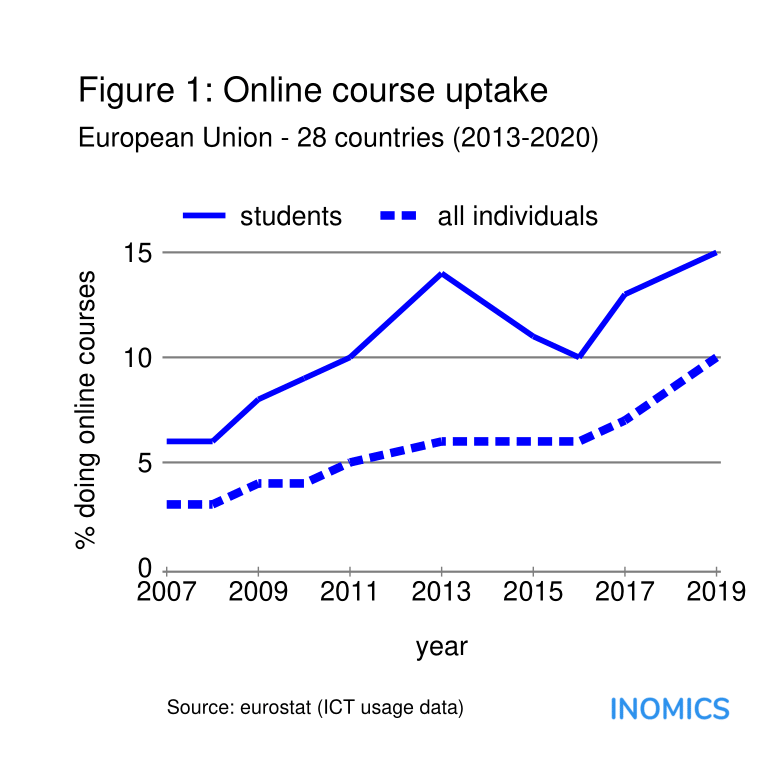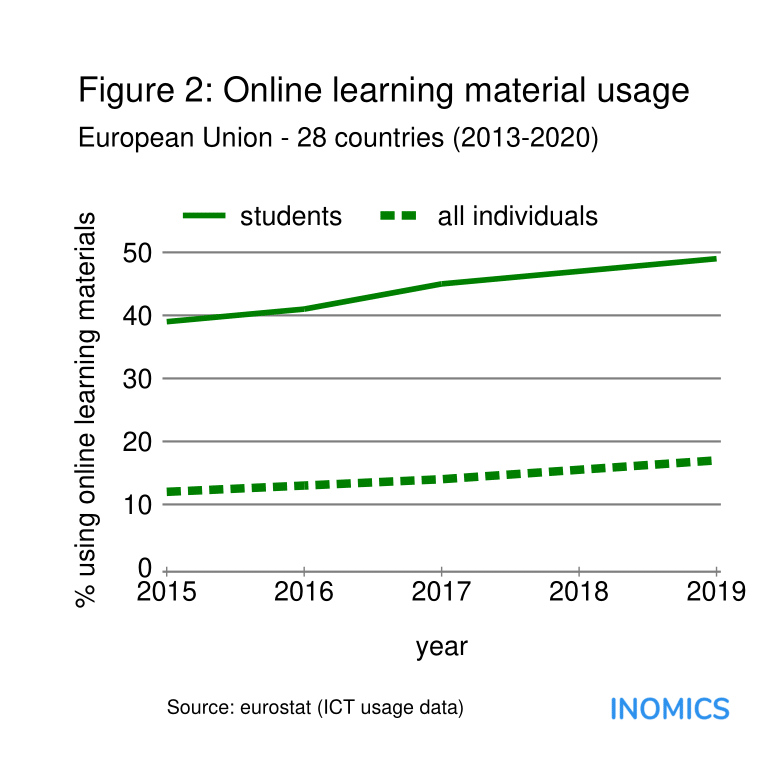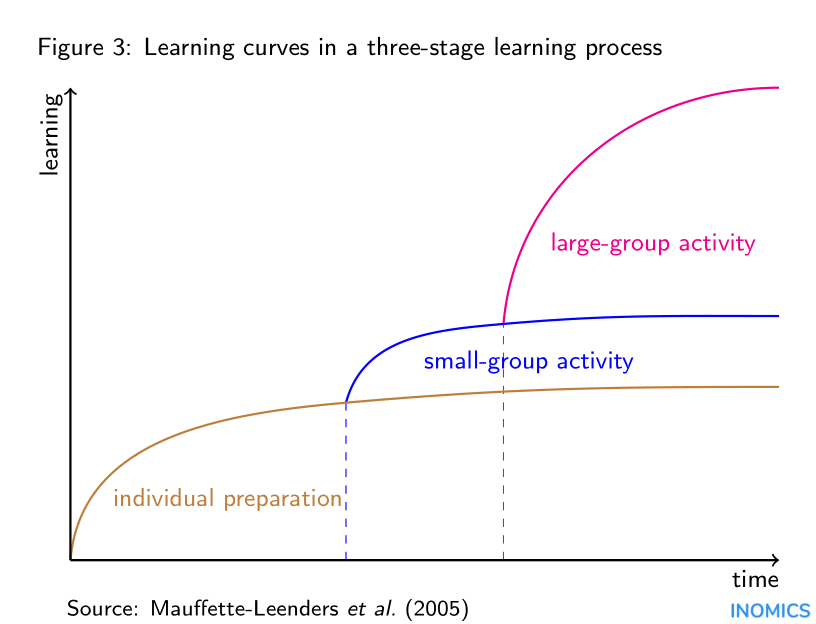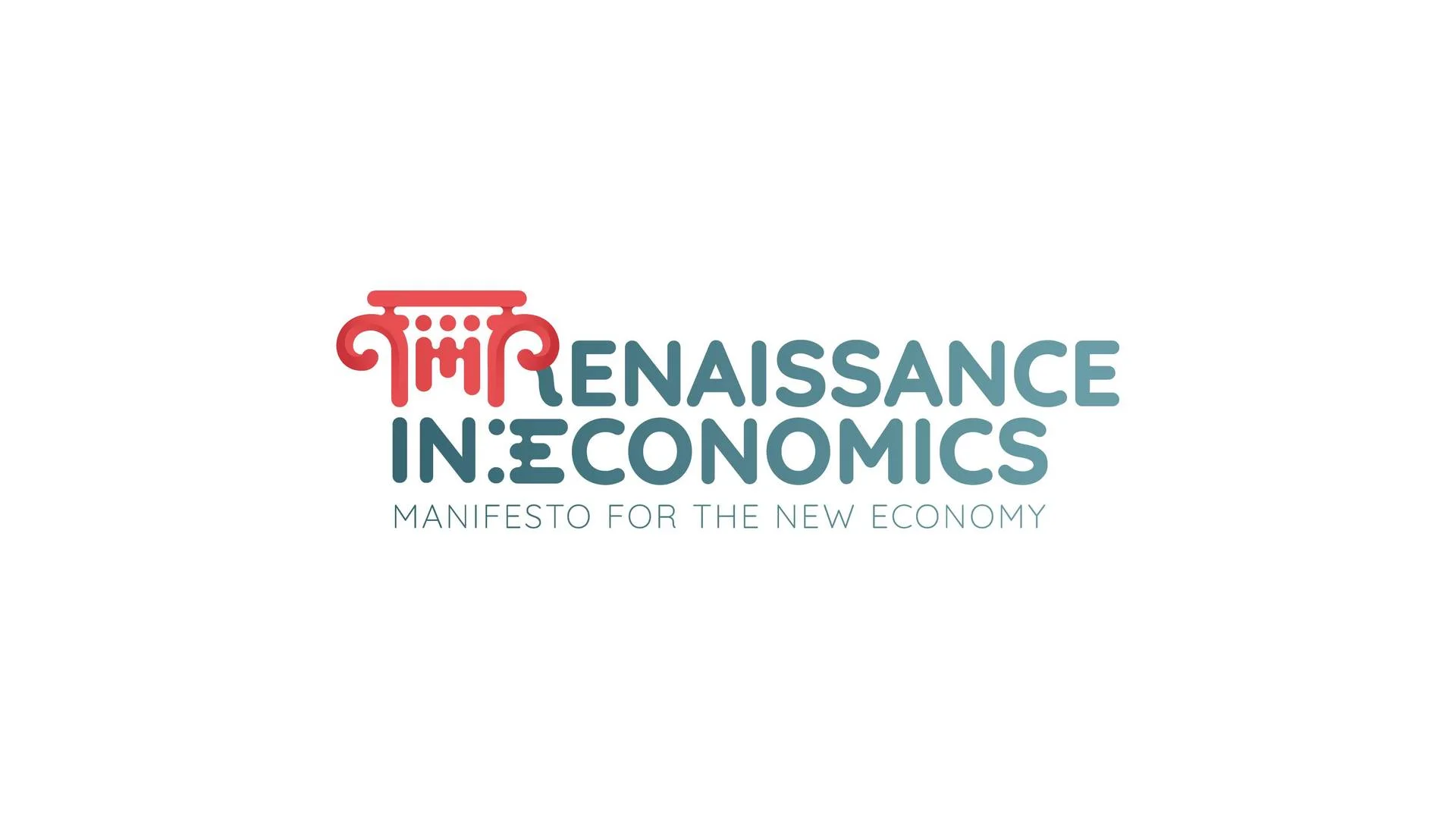
Online Education
From University Campus to Remote Education: How Steep is the Learning Curve?
Read a summary using the INOMICS AI tool
Universities around the world are currently experiencing a crash course in online education. The coronavirus pandemic has shaken the sector in a big way, leaving professors and students struggling to complete the academic year off campus and having to prepare for the next one under very uncertain circumstances. Although online learning has been around for at least two decades, adapting all courses to remote forms of education is proving a steep learning curve for most institutions. Applying a basic economic principle and considering some of the evidence on online versus traditional teaching methods can help to assess the likely effects of recent campus closures on student learning outcomes and to see how course provision and programme design may develop in the longer term.
Distance learning is nothing new; it has existed in one form or another ever since people were first able to exchange letters and talk on the telephone. In 1858 the University of London started to offer students the opportunity to study for degrees remotely. With the invention of the record player, radio and television, the possibilities for distance learning expanded but it was not until 1969 that a national government created the first institution of Higher Education to specialise in distance learning, the Open University. With the arrival of home computing and the internet in the mid to late 1990s, online learning began to evolve as a viable means for universities to deliver their degree programmes. Yet despite the increasing ubiquity of the internet in daily life since then, enrolment in online courses has been somewhat muted. As of 2019, only 15% of registered students in the European Union were taking an online course in any subject, versus 10% of all individuals living in the EU (Figure 1). This contrasts with just under half of students who used the internet to access learning materials in 2019 (Figure 2). While the trend in online education was already positive before the coronavirus pandemic, a majority of professors and students in Europe still relied on traditional methods for their teaching and learning.

As universities shut down campuses and embraced remote learning in response to the pandemic, existing technologies were quickly harnessed to shift lectures, seminars and assessment online wherever feasible. In principle, from a student perspective, there are many advantages of online learning over the traditional classroom, including increased flexibility in time management and the ability to adjust the pace to suit individual learning. However in practice, the unexpected nature of the switch to online methods has left many students dissatisfied with their instructors’ efforts and this has led to claims for refunds and reductions in tuition fees. Faced with ongoing uncertainty over the forthcoming academic year, some institutions are preparing to extend remote education across the board for the foreseeable future. It is important for institutions to organise this in ways that continue to engage students and facilitate learning.

One of the strengths of a traditional on-campus education in many subjects is the ability to have students combine individual preparation for class with working in groups. Mauffette-Leenders et al. (2005) advocate a three-stage learning process in which students 1. prepare a topic individually, 2. form small study groups before 3. the whole class is brought together in a seminar for a fruitful discussion of the topic at hand. There is only so much an individual student can learn by reading alone. Feedback in a small group of fellow students can accelerate learning. Having a variety of such groups with different dynamics subsequently attend class together under the guidance of an instructor then boosts learning further. Figure 3 illustrates this simple three-stage process whereby the student effectively jumps between stages onto a steeper learning curve each time. Economists will recognise the concept of diminishing marginal returns in the graphs as the potential for additional learning at each stage lessens over time. Student learning is thus accelerated and made more efficient through the timely combination of individual and group work.

The law of diminishing marginal returns is equally applicable to online learning. It is therefore useful for university administrators and course leaders to consider how learning outcomes may be reached more efficiently through different combinations of individual study formats, contact for students with their peers, as well as larger group formations, when redesigning degree programmes for remote education. Students who learn off campus have more autonomy and would also do well to bear in mind the marginal returns to time invested when structuring their study periods.
Within the discipline of economics, much of the evidence on learning outcomes from remote education is based on analyses of general introductory undergraduate courses such as “Principles of Microeconomics” that are taught to some students online and to others in class. Grades of those studying online are often higher than grades of students taught in class. However selection into online variants of courses is rarely random, with students of higher ability being more likely to opt for them. Studies that control for selection bias tend to find either little difference or slightly weaker performance of students who learn online (Allgood et al., 2015). The implication of this is that stronger students who have chosen to study online may have performed better had they attended a traditional class, while weaker students who remain in class may fare worse if they switch to online learning.
Government restrictions imposed to stem the coronavirus pandemic have left institutions of Higher Education with little choice but to try and teach remotely. Many lessons will have been learned from this experience. Some aspects of traditional on-campus learning may be irreplaceable, including access to physical facilities such as laboratories as well as the bonds of trust that students build with their peers and their instructors. Once universities regain control over where to locate teaching, they will in all probability move towards hybrid models that combine shorter times on campus with an increased amount of remote, online learning for students. Above all, the learning curves should be optimised and sweet spots sought where the marginal cost of learning equals the marginal value of knowledge gained.
References
Allgood, S., W. B. Walstad, and J. J. Siegfried (2015) Research on Teaching Economics to Undergraduates, Journal of Economic Literature 53(2), 285–325.
Mauffette-Leenders, L. A., J. A. Erskine, and M. R. Leenders (2005) Learning with Cases, 3rd edition, London, ON: Richard Ivey School of Business, University of Western Ontario.
-
- Conférence
- Posted 2 weeks ago
45th RSEP International Multidisciplinary Conference
Between 4 Feb and 5 Feb in Lisbon, Portugal
-
- Workshop, Conference
- Posted 1 week ago
Call for Papers: 3° International Conference Renaissance in Economics 2026
Between 14 May and 15 May in Rome, Italie
-
- Postdoc Job
- Posted 1 week ago
2 Post-Doctoral Positions in Monetary Economics 100%
At University of Bern in Bern, Suisse














